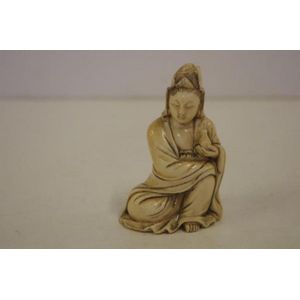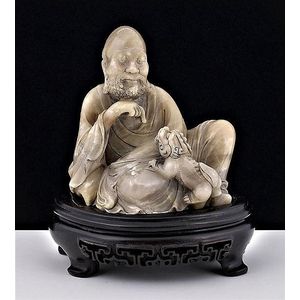Qing Dynasty Luohan Soapstone Figure with Buddhist Lion
You must be a subscriber, and be logged in to view price and dealer details.
Subscribe Now to view actual auction price for this item
When you subscribe, you have the option of setting the currency in which to display prices to $Au, $US, $NZ or Stg.
- Incised - A record of a name, date or inscription, or a decoration scratched into a surface, usually of a glass or ceramic item with a blunt instrument to make a coarse indentation. Compare with engraving where the surface is cut with a sharp instrument such as a metal needle or rotating tool to achieve a fine indentation.
- Ming Dynasty - The Ming Dynasty was a ruling dynasty of China from 1368 to 1644. It succeeded the Yuan Dynasty and preceded the Qing Dynasty. The Ming Dynasty was established by Zhu Yuanzhang, a former Buddhist monk who became a rebel leader and eventually overthrew the Mongol Yuan Dynasty. During the Ming Dynasty, China experienced a period of relative stability and prosperity. The government was centralized and bureaucratic, with the emperor at the top of the hierarchy. The Ming Dynasty is known for its cultural achievements, including the development of porcelain, the invention of movable type printing, and the construction of the Great Wall of China.
This item has been included into following indexes:
Visually similar items

Antique Japanese carved ivory lady figurine, signed to base, 8 cm high approx

Antique Staffordshire figure on horseback

A Victorian Copeland Parian figure of 'Rebekah', dated 1857, after the original sculpture by W. Theed, impressed marks. 46 cm high

A soapstone figure of a Luohan with lion, Qing Dynasty, 19th century the bearded man seated with left knee raised, wrapped in long robes falling over a double gourd beneath his right arm, his right hand raised beneath his chin, as he gazes down at the lion
